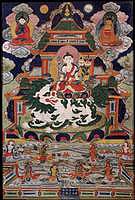
|
Bodhisattva Avalokiteshvara (painting no. 519)
|

View Larger Image |
||||||||||||||
|
Simhanada, Avalokiteshvara (Tibetan: seng ge dra, chen re zi, English: the Lion's Roar, All Seeing Lord). In front of an ornate palace Simhanada is seated on a lotus on the back of a lion with a green mane in turn seated upon a larger lotus; "... with a body white in colour, one face, two hands, three peaceful eyes, with the face slightly smiling. The right hand is extended above the knee in the mudra of giving refuge. The palm of the left hand is supported on the moon seat, holding the stem of a red lotus, the petals blossoming next to the ear. Above is the cleansing blue sword of wisdom. The left breast is covered with the skin of a krishnasara deer; encircled with a white Brahmin string necklace; with a lower garment of red silk. The body is slightly thin and dexterous. At the left above a red lotus with eight petals is a skullcup filled with various fragrant flowers; at the right, a trident with a green shaft entwined with a white snake. The left [hand] is in the gesture of holding a fragrant lotus." (Written by Yarlungpa Senge Gyaltsen, 13th century). At the top left is the Buddha Nagaraja (King of the Nagas) with a body blue in colour and a white face. The head is adorned with a canopy of seven hooded snakes. With the hands he displays the mudra (gesture) 'which prevents lower births.' At the right is the Indian pandita Arya Nagarjuna wearing monastic robes and also adorned with a canopy of hooded snakes above the head. In front of the palace, in the cool reflection pond, containing many precious objects are the eight great nagas: Vasuka, Karkota, Shankhapala, Ananta, Takshaka, Kulika, Padma and Mahapadma. These mythical creatures of the animal realm, in various colours, have a human upper body and the lower body of a snake. In the presence of Simhanada their hands are folded together in a gesture of respect. Simhanada Avalokiteshavara belongs to the Kriya Tantra classification and arises from the Simahanada Tantra and the text of the Arya Avalokiteshvara Dharani. His primary activity is to remove sickness and disease especially illness caused by nagas. Jowo Atisha and Mal Lotsawa popularized the practice of Simhanada in the land of Tibet. Lineage: Vajradhara, Simhanada, Candragomin, Shridhara, Naropa, the Phamting Brothers, Asthulya Vajra, Manju Ling Thugje Chenpo, Mal Lotsawa, Sachen Kunga Nyingpo (1092-1158), etc. J.Watt 6-98
|
|||||||||||||||
Photographed Image Copyright © 1998 Shelley & Donald Rubin Foundation
|
|
| |
Next Image |